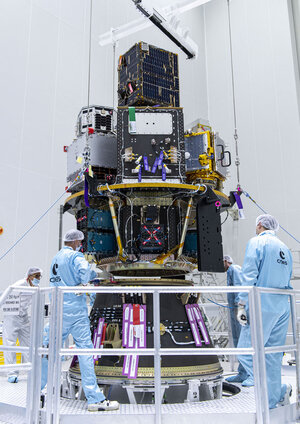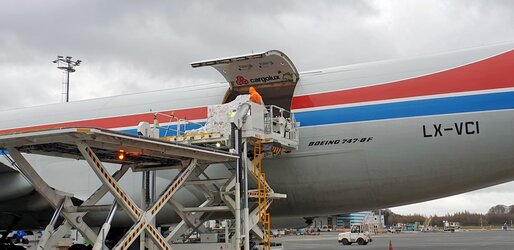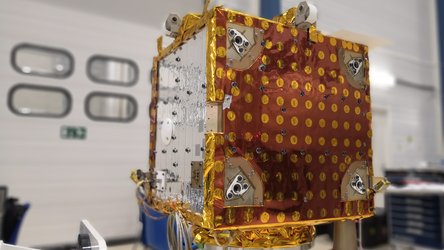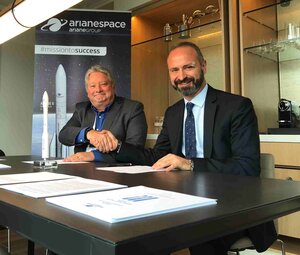ESAIL maritime satellite launched
The ESAIL microsatellite for tracking ships worldwide – developed under ESA’s Partnership Projects programme – has been launched aboard an Arianespace Vega from Europe’s Spaceport in Kourou, French Guiana.
The launch took place at 02:51 BST (03:51 CEST) on 3 September.
ESAIL was one of 53 satellites on Arianespace’s rideshare adapter for Small Satellite Mission Service and was deployed into a Sun-synchronous orbit at an altitude of more than 500 km.

ESAIL will track ships worldwide by detecting messages that ships radio-broadcast with their automatic identification systems (AIS).
As part of Canadian operator exactEarth’s satellite-based automatic identification systems (SAT-AIS) constellation, ESAIL will provide ship data to the European Maritime Safety Agency for the next generation of global maritime traffic services.
This enables fisheries monitoring, fleet management, environmental protection and security monitoring for maritime and government authorities and industry – making the seas safer.

ESAIL was developed in an ESA Partnership Project with LuxSpace and ExactEarth as part of ESA’s SAT-AIS programme.
The high-performance microsatellite was built by LuxSpace, involving a large number of European small and medium-sized enterprises, with the support of the Luxembourg Space Agency and other ESA member states.

Elodie Viau, Director of Telecommunications and Integrated Applications at ESA, said: “The successful launch of ESAIL illustrates ESA’s ability to adapt the innovative approaches of new space to manage microsatellites.
“ESA’s Partnership Projects federate industry around sustainable end-to-end systems up to in-orbit validation, achieving competitive leaps forward and economic impacts. They help to de-risk partners investments to answer market needs, and maximise the benefits to industry, thanks to ESA’s efficient co-management approach tailored to commercial best practices.
“I would like to thank our industrial partners and participating states for their trust and close cooperation.”

Peter Mabson, chief executive of exactEarth, said: “We are delighted to add ESAIL to our industry-leading global maritime satellite constellation. Its capabilities will allow us to continue to advance the state-of-the-art in maritime vessel tracking and data services, and will pave the way for future capabilities. I would like to thank ESA and LuxSpace and their satellite manufacturing team for their accomplishments in producing this cutting-edge microsatellite.”
Marc Serres, chief executive of the Luxembourg Space Agency, said: “As a European leader in commercial space, Luxembourg is following a unique space strategy focused on creating an attractive ecosystem for NewSpace companies and innovative space entrepreneurs. This maritime microsatellite built in Luxembourg by our major system integrator LuxSpace, in partnership with ESA, demonstrates how a private company and ESA can closely work together to develop a new commercial product.”

ESAIL is the third AIS satellite for LuxSpace – but also the largest so far. The company is currently developing a multi‐purpose, modular platform called Triton‐X. This platform will build on the manufacturing and testing heritage gained by LuxSpace through ESAIL, using off-the-shelf components to deliver a fully-fledged satellite within months.
Jochen Harms, Managing Director at LuxSpace, said: “ESAIL is a major milestone for us. It enabled us to build and integrate a sophisticated microsatellite using commercial off-the-shelf components, which reduced the time for testing and launch qualification. The emerged synergies paved our way towards commercial space. We have gained valuable experience and knowledge through ESAIL, which serve as inputs for the Triton‐X platform.”


Access the video














 Germany
Germany
 Austria
Austria
 Belgium
Belgium
 Denmark
Denmark
 Spain
Spain
 Estonia
Estonia
 Finland
Finland
 France
France
 Greece
Greece
 Hungary
Hungary
 Ireland
Ireland
 Italy
Italy
 Luxembourg
Luxembourg
 Norway
Norway
 The Netherlands
The Netherlands
 Poland
Poland
 Portugal
Portugal
 Czechia
Czechia
 Romania
Romania
 United Kingdom
United Kingdom
 Slovenia
Slovenia
 Sweden
Sweden
 Switzerland
Switzerland































